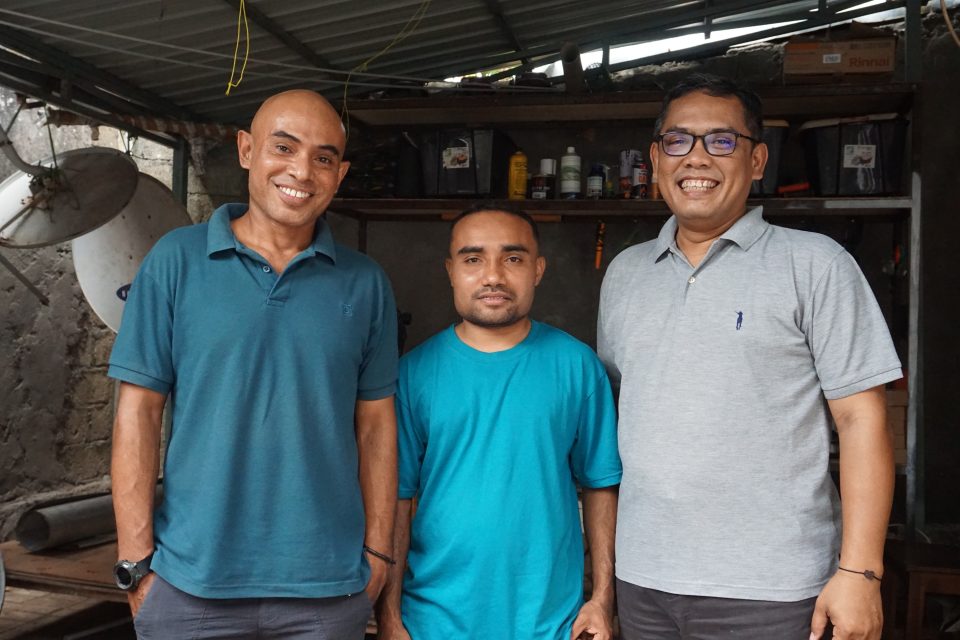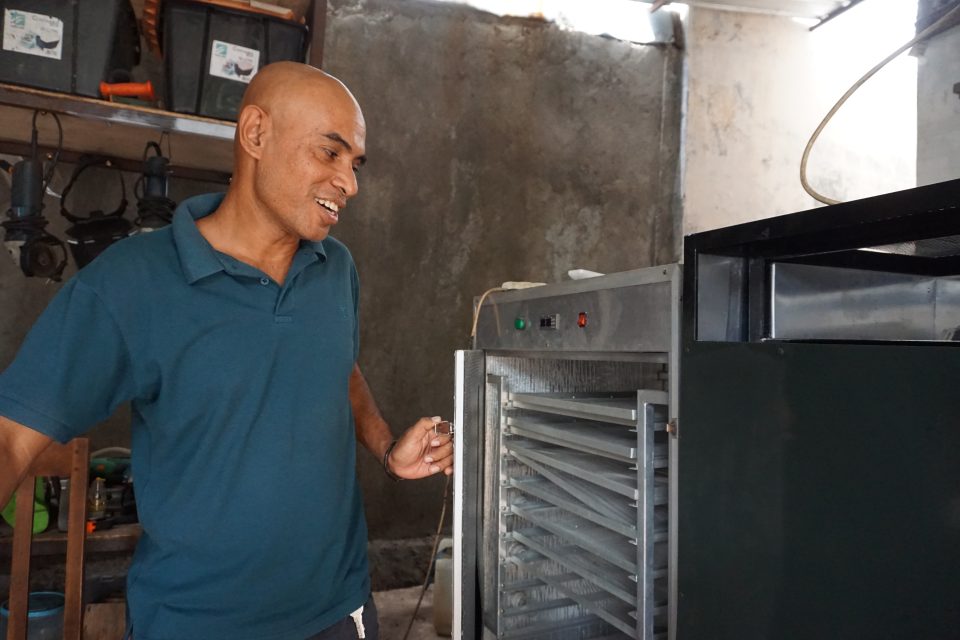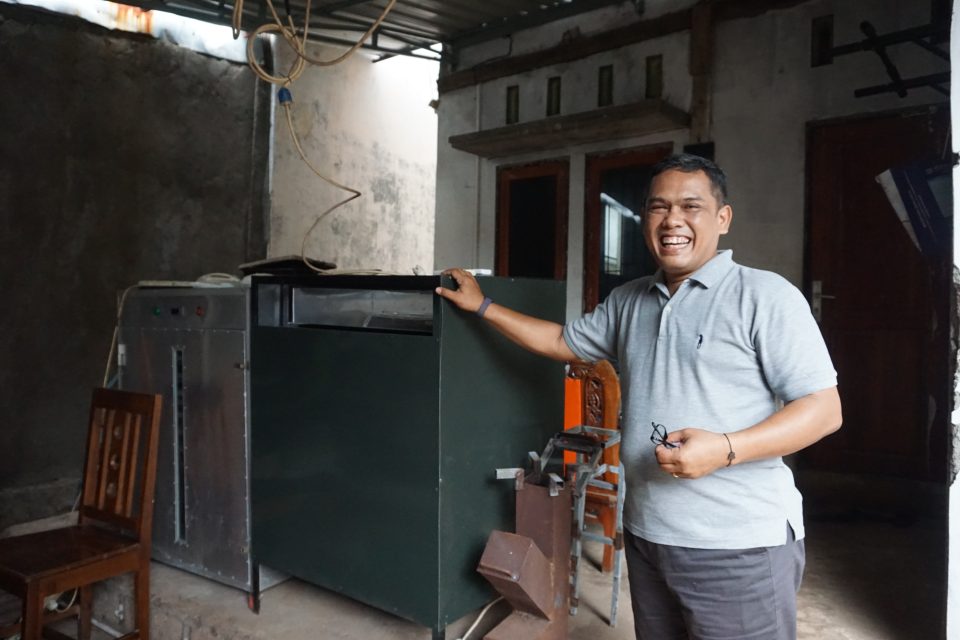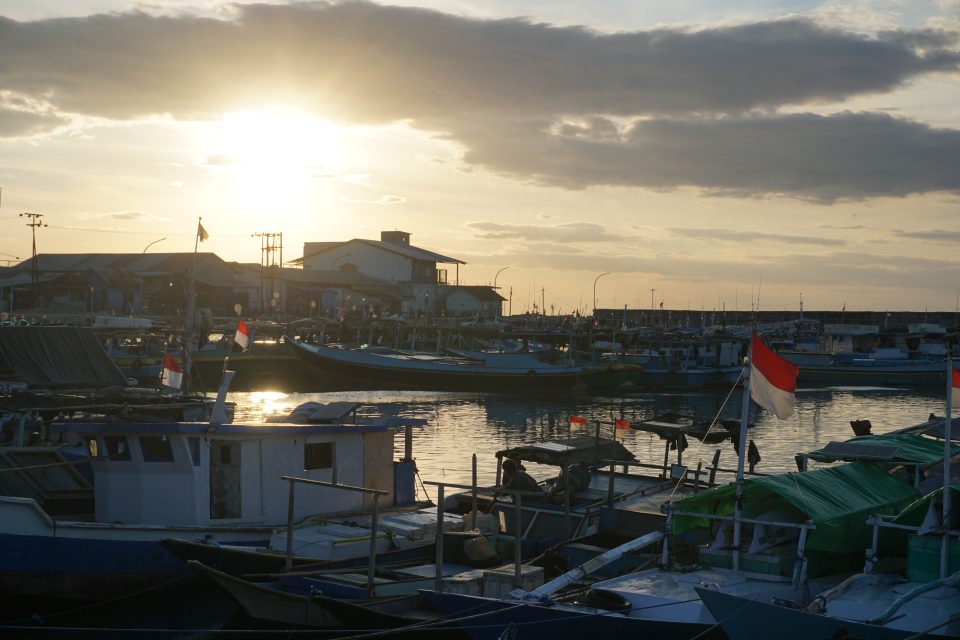In the vast and varied landscapes of East Nusa Tenggara (Nusa Tenggara Timur or NTT), innovation doesn’t just mean new technology. It means survival. For many communities across this archipelagic province, daily life is shaped by scarcity: of water, electricity, and reliable infrastructure. But it’s also shaped by resilience, creativity, and a deep sense of adaptation.
This is where Kuantek, short for Kuan Timor Technology (Teknologi Kampung Timor), is planting its roots and building climate solutions that emerge not from abstract theory, but from the lived experiences of the people they aim to serve.
Co-founders Ben Vasco Tarigan, Abraham Talluta (CEO), and Abdi Nenotek (CTO) do not claim to have all the answers to NTT’s struggles. But they do have one thing that many technology companies overlook: they listen.

Kuantek Co-Founders: Abraham Talluta (CEO), Abdi Nenotek (CTO), and Ben Vasco Tarigan.
“We always ask our users: Apa yang paling menyakitkan? What’s the most painful part of your day?” says Ben. “We design our products from there.”
To Kuantek, listening isn’t just a design principle – it’s their business model.
Three years after its founding, Kuantek connected with New Energy Nexus Indonesia through the IKEA Foundation-funded Smart Energy Incubation Program and the [RE]Spark Hackathon. At the time, they had a clear target – addressing NTT’s lack of access to clean water. Their solution was to build an affordable seawater desalination system to produce drinkable water for coastal communities.
From this one idea, Kuantek kept evolving. They began developing a range of environmental technologies designed to address the needs of rural and remote populations, from preserving produce with little energy cost to making water out of air.
The three innovators weren’t siloed in labs. Instead, they co-created their products with the very communities that will reap the benefits. Each innovation started with a simple premise: Making life easier, using what the community already has.
The dehydrator that changed the game
One of Kuantek’s most talked-about products is their low-power dehydrator, a tool that’s now helping farmers in Timor dry and preserve chili and vanilla crops for longer shelf life and higher selling prices.
Getting dehydrators is a smart economic move for farmers. It allows farmers the option to dry and store fresh produce, instead of having to sell it quickly to avoid spoilage. This gives them more control over pricing and market timing.
However, commercial dehydrators often require up to 1000 watts to operate, and in rural areas such as those in Nusa Tenggara Timur, the power capacity per household only reaches up to 500 watts. That’s where Kuantek came in.
“We designed ours to run at just 270 watts,” says Ben. The secret is a combination of energy-efficient lighting systems and localized materials. “It’s not just about being energy-efficient. It’s about making sure people can actually use it.”

Kuantek’s low-watt food dehydrator
Harvesting water from thin air
Another of Kuantek’s solutions is a system that converts humidity from the atmosphere into potable water, using solar energy. This technology is particularly suited for some areas in NTT, where air humidity is high, but water sources are often inaccessible or unsafe.
Ben envisions installing these atmospheric water systems in schools and highland tourism areas, especially in places where groundwater is either unavailable or requires expensive and unsustainable drilling.
“We want to eliminate the need for groundwater wells in hard-to-reach areas,” he said. “Instead, let’s use what we already have: heat, air, and sunlight.”
In a pilot project, they installed a solar thermal-powered water station in a coastal village. Three months later, the local pastor reported something profound: for the first time, they had no trouble getting clean water. “That’s when we knew we were doing something right,” Ben said.

Solar-powered water harvesting system
Designing through constraint
While their ideas may be bold, implementation is often difficult, as NTT’s geography presents a host of logistical barriers.
Some islands can only be accessed by small boats that can’t carry heavy machinery. Roads are narrow, winding, and poorly maintained. In many villages, bridges don’t exist, and rivers swell during the rainy season, cutting off access altogether.
This makes even the most well-designed product a challenge to deliver. Kuantek had to rethink their seawater desalination system when they realized the original version was too large for local transport networks.
“So we redesigned the whole thing to be smaller, but with the same capacity,” Ben explains. “It wasn’t just about making it small, it was about making the technology mobile, modular, and manageable.”
A culture of listening
For Kuantek, the job doesn’t end at innovation. Often, it begins long before product design, and continues well beyond delivery.
Their team frequently plays the role of advocate, helping villages navigate complex systems like reporting power outages to PLN, the state-owned power company. They also introduce basic feedback mechanisms so that communities feel empowered to ask for improvements or raise concerns.
“Sometimes our work is as simple as showing people how to talk to PLN,” Ben said, laughing. “Other times, we’re advocating for completely new systems to be built.”
They are also aware of the challenges of behavior change. Many people in rural NTT have adapted to unreliable electricity and limited water access, often without realizing it. That makes introducing new technologies tricky.
“It’s incredibly difficult to ask someone to adopt new behaviors,” Abraham said. “So instead, we look at the things they’re already doing, and we design from there.”
This empathetic approach ensures that technologies don’t feel foreign or intrusive, but intuitive.
When it comes to criticism of their business, Ben sees it as very valuable insight. Rather than resisting feedback, they see it as an invitation to collaborate.
This philosophy has allowed Kuantek to keep improving, even with limited resources.
“Disagreements and pushback are something I see as gifts. When people tell us what’s wrong, they’re actually helping us make the product fit better,” he reflects. “It’s our job to listen, iterate, and make it real.”

Kupang, East Nusa Tenggara
A data-driven dream
Looking to the future, Kuantek is embarking on an ambitious initiative: mapping the infrastructure, climate, and behavioral patterns of every district in NTT.
They want to build a data bank – a library of regional insights that can guide future innovations and help them develop tailored, low-emission technologies suited to each community’s unique needs.
“Some areas are hot, dry, and windy. Others are humid or rich in seawater. Every place is different,” says Ben. “But if we know the conditions, we can create the right solutions.”
Beyond the benefit to their business, Kuantek wants the database to be an open reference point for governments, entrepreneurs, universities, and other innovators who want to build effective, community-centered technology in rural Indonesia.
Their dream is to make technology accessible and replicable. “Even if it’s simple, if people understand how it works, they can build it themselves,” Ben says.
Kuantek sums up their entire approach in five words: “Datang, Duduk, Diskusi, Design, Diseminasi (5D),” which translates to “Come. Sit. Discuss. Design. Disseminate.
More than a method, it’s a mindset that values patience over speed, trust over disruption, and purpose over profit.
“Where there are a thousand problems, there are also a thousand solutions,” says Ben. “Our job is to figure out how to tackle them.”
For all the challenges NTT presents, the people soldier on every day to live on to the next. They are what inspires each small invention at Kuantek. In turn, the company’s technologies seek to ease their burdens and build a cleaner future, in NTT and beyond.
Want more clean energy stories and opportunities in Indonesia? Check out New Energy Nexus Indonesia here.